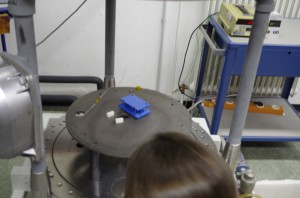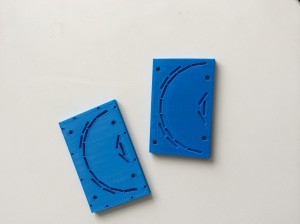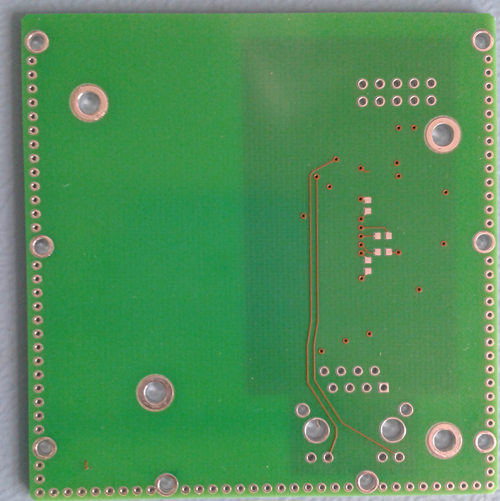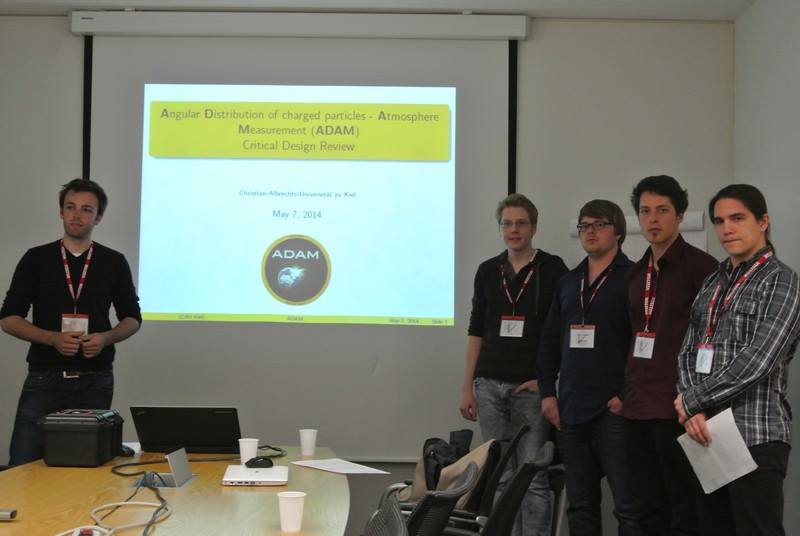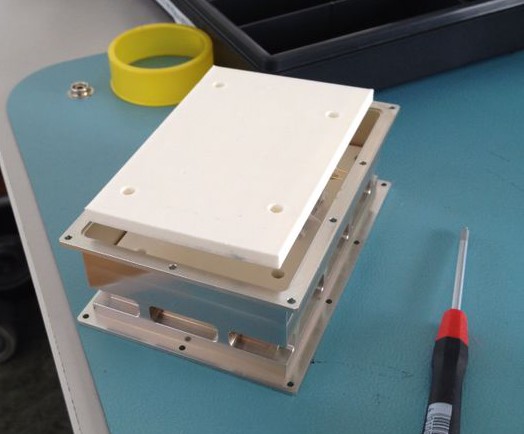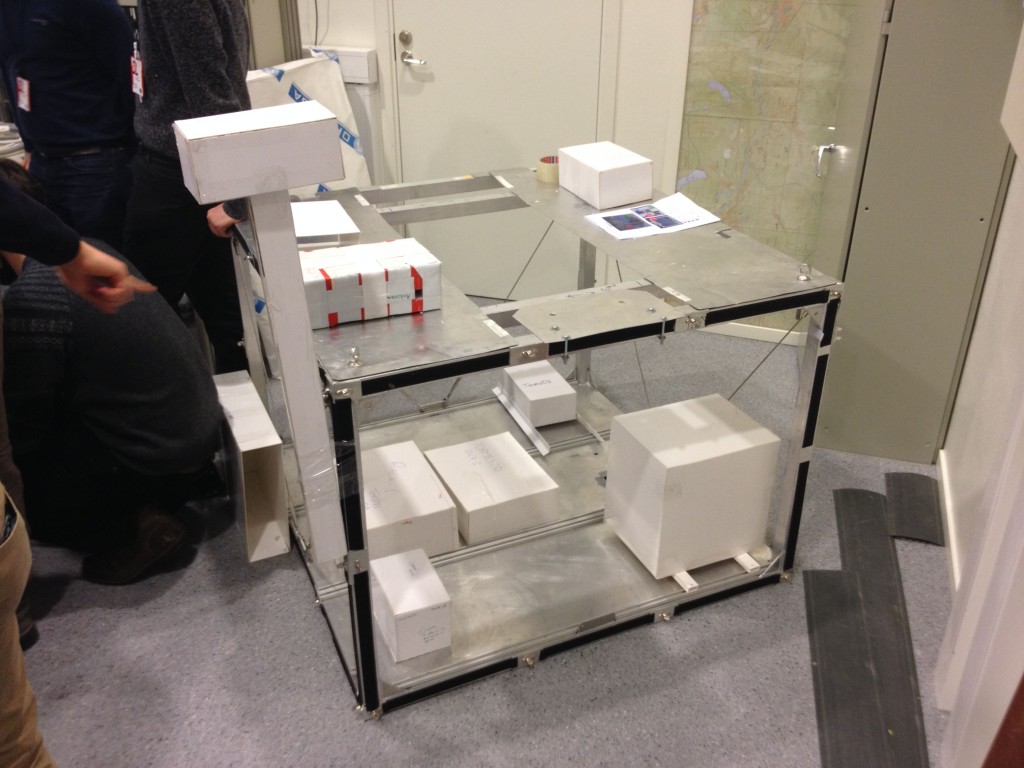On tuesday we performed a first vacuum test, to see if our 3D-printed sensor head plates show any sort of outgassing or deformation and thereby if 3D printed items are generally usable in the expected pressure environment.
The test was successful, no one got harmed, the laboratory is still intact and no outgassing or deformation has been registrated.
Now, further and more detailed tests will hopefully confirm this result.
The boards arrived!
This week our new designed boards, the 18 channel preamp board and the Ethernet board, were delivered. Finn and Sebastian already started soldering them and hopefully we can start taking first measurements with our instrument EVA soon. Furthermore all last orders like aluminum profiles, rubber buffers and most important the SSDs for EVA are out now. If they are delivered in time we can start assembling the experiment during the next few weeks!
Successfull CDR
We are back from the Critical Design Review event at ESA ESTEC in the Netherlands.
It were two really nice days and the best was: during our CDR we got a lot of positive feedback. But we are not perfect so there are still some slight improvements to be done. Right after that we can allocate most of our time into manufacturing and testing our instrument.
Efficient Working in a Team: Team Forum
We use a forum to communicate within the team. This is because a chronological communication like in a chat has several problems:
- no sorting (but chronological)
- merging of chat and serious communication
- hard to find information („Where is the link to the data sheet of the diodes?!“)
Instead of a chat we use a team forum for non personal communication within the team. As a result we don’t have to worry about the drawbacks mentioned above. Furthermore by using a forum, every communiation is being saved and backuped and can be reviewed later if necessary.
Efficient Working in a Team: Using Textfiles instead of binary data
You all know this situation. There is a template for an MS Office file e.g. Word and all team memvers begin to work with it. Everything is fine until you want to merge the files of each member. If it is possible someone has the task to collect all files manually by mail, open them on his PC and merge them together manually. Typical problem occur like formatting problems. After this person has merged the files he has to sent them to the team and the cycle starts again.
We don’t want to waste time by doing things which can be done by a PC faster and better. Therefore we use Latex, which is an improvement of Tex, and the IDE TeXstudio. We split the document up in:
- header (which contains the formatting variables)
- titlepage
- main document (which is very short and has only „\include“ commands)
- chapters (Each chapter is a own *.tex file)
- last page
So we won’t have the problems described above.
Efficient Working in a Team: Subversion-Repository
In the next days I will tell you about three habits, which increase our productivity:
- Using a Subversion-Repository
- Using a team-forum for communication
- Using textfiles instead of binary data
Subversion Repository:
Wikipedia says:
„Apache Subversion (often abbreviated SVN, after the command name svn) is a software versioning and revision control system distributed as free software under the Apache License.[1] Developers use Subversion to maintain current and historical versions of files such as source code, web pages, and documentation. Its goal is to be a mostly compatible successor to the widely used Concurrent Versions System (CVS).“
We use a central server in our intitute, in which the svn-server is installed. All our project data the data is being stored there (including history).
To use the system on a certain computer for the first time, we „check a working copy out“, which means all the data from the server will be transmitted to a local directory on our PC.
Now we can work with the data until we want to finish our working day. In that case we commit our data to the server. There is one fact, which increases the speed of the transmission: Only the differences will be transmitted. E.g. you work on a whole book with tousands of pages and only change a comma, then only one line will be transmitted.
If you want to start your new working day, first you have to update your working-copy. Same as above – only the differences in the files will be transmitted. If you nwork with textfiles the update procedure will only last a few seconds.
The server will store all revisions until the storage is full. So e.g. I want the status of our SED from a certain time on a certain day, that’s no problem.
If you are interested in this software, visit:
3D-Printing for Critical Design Review
One of our main goals is to design and optimize a mounting solution for the SSDs of our instrument EVA. Therefore we create plates with grooves, in which we will jam the SSDs.
Because it is expensive and relatively slow to order them from an external manufacturer, we use a 3D-printer that we have in our institute. This way we can print a huge number of different adjustments easily and fast, e.g. a prototype plate for the CDR.
We still need to test if these plates fit our needs related to vacuum. If YES, we will optimize our sensor head design for the 3D printer. If NOT, we will order the plates at a workshop the old fashioned way.
PDR today!
Today we gonna have our Preliminary Design Review here at ESRANGE. We are looking forward to a constructive discussion!
Yesterday we had an experiment-mockup construction session to check the arrangement of the experiments on the BEXUS gondola. Our experiment is the big box on the right bottom corner of the gondola.
Second day in Esrange
After arriving one day later than all the other teams, we are looking forward for our second day here in Esrange and the PDR.
Greetings from team ADAM in Frankfurt
Flight was cancelled, now we are taking a detour via Frankfurt to Stockholm and won’t reach Kiruna for the preliminary design review (PDR) today. Hopefully we have better luck tomorrow.

